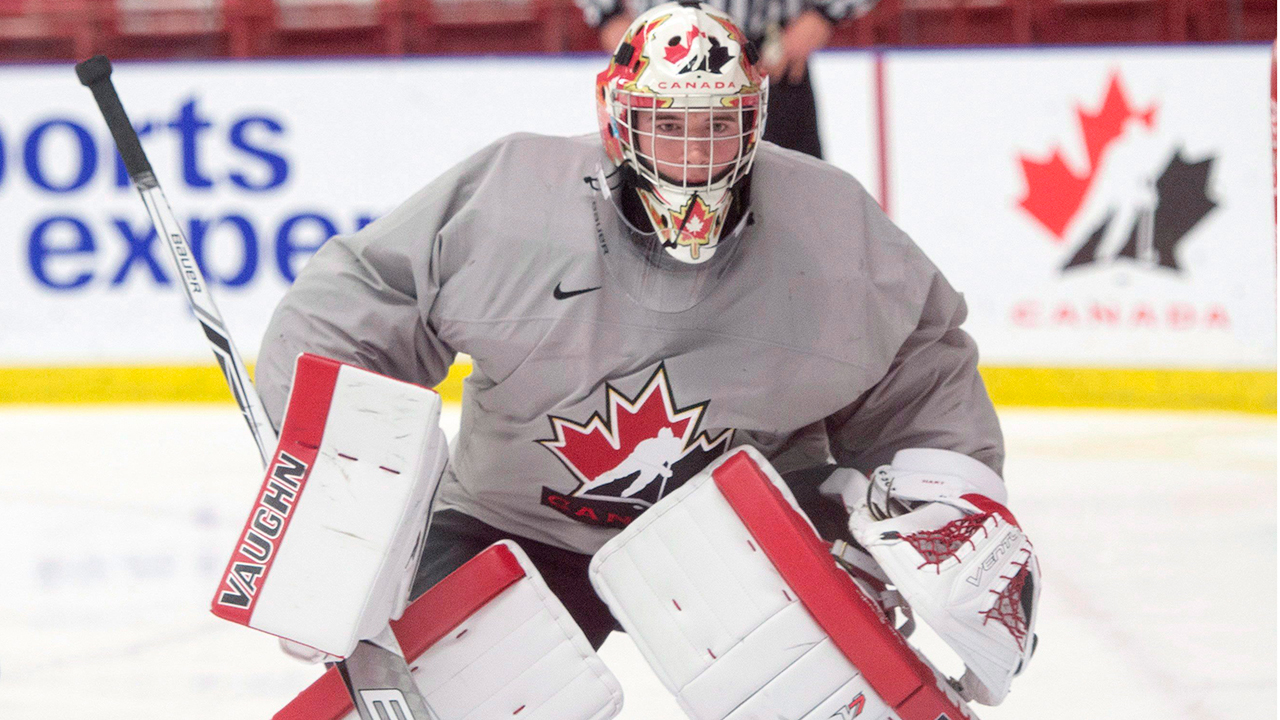There’s just one truly meaningful and suspenseful game left on the Toronto side of the draw at the 2017 World Junior Championships and it’s not the relegation death match between Slovakia and Latvia that will play out on Friday at the ACC.
No, all that’s left is another edition of the biggest rivalry in junior hockey, Canada versus the U.S. on New Year’s Eve and with the first seed going into the elimination round at stake.
Both teams have played three games so far in the first round and faced only one truly stiff test, their contests against Russia. The host team’s 5-3 win over the Russians opening night was a little more authoritative than the Americans’ 3-2 victory but not enough to declare Canada a clear favourite going on in the tournament.
To an extent, the two teams’ wins over Russia followed a similar arc—strong starts followed by life-or-death struggling to close the deal. For Canada it was the dicey goaltending of Carter Hart that threatened to let the game get away, for the U.S. a very passive 1-3-1 system to protect a very fragile lead.

On the latest podcast, Gare Joyce from Toronto and Eric Engels from Montreal join the guys to talk all things world juniors.
Listen now | iTunes | Podcatchers
Neither team should take too much confidence if they draw the Russians when the tournament moves into the elimination round. They remain a danger team. Maybe coach Valeri Bragin can inspire them with the old “Let’s win one for the 35 expelled ‘diplomats'” speech. If the Russians can figure out a way to play for 60 minutes like they did for the third period against Canada and the last two periods against the U.S., they have a chance to win the tournament.
That’s how it played out in Buffalo back in 2011. In that tournament Russia lost opening-round games to Sweden and Canada and took the gold by beating the Swedes in the semis and storming back from three goals down in the third period of the final against the Canadians.
Let’s leave the Russians for further discussion when they pack off to Montreal.
Going into the New Year’s Eve game, you have to give the U.S. and advantage over Canada in goal. Tyler Parsons faced 27 shots in the American net and was blameless on the two goals. He was the Americans’ best player Thursday afternoon, more tested under pressure that he didn’t face when he stood in the London Knights’ cage on their run to the Memorial Cup last spring.
As noted above, Carter Hart didn’t impress against Switzerland in the final exhibition game, didn’t impress in his first tournament game, the tilt with the Russians. and didn’t put any concerns to rest with his performance in the 9-2 win over Latvia. While they weren’t going to make a game of it, the Latvians put two pucks past him for goals and a third one through him—all that spared Hart a goal against on the latter was an ref’s whistle.
The read on Hart from one NHL goaltending consultant: “He’s a blocker. He consistently doesn’t control rebounds. He plays in Everett where [coach] Kevin Constantine plays a complete shutdown system … the support around [Hart] is there. But this is a different situation.”

Not a scout? No worries. Jeff Marek’s newest podcast is all you need.
Listen now | iTunes | Podcatchers
Even against bracket minnow Latvia Thursday night you saw instances of Hart squaring up and giving up rebounds like a handball wall, the puck going right back to the shooter. Against Latvia, that wasn’t an issue but with the U.S. it’s a potential problem—speedy, elusive American forwards like Clayton Keller and Colin White can crash the net and collect second chances blocked or punted back to them.
The challenge for Canadian blue liners such as Thomas Cabot, Philippe Myers, Jake Bean and Noah Juulsen is not just staying between the U.S. forwards and the net for gifts chances but not losing the shooters once they let fly. A complicating factor: Hart plays deep in his crease, so a big rebound can sit in a wide open space.
If you line up the Canadian and American teams you see a significant difference in size, particularly up front. The U.S. created forechecking pressure early in their game against Russia mostly with speed and work rate, not heft.
Ditto the Americans’ possession game in the Russian end through the first period. They have a couple of big bodies—Jordan Greenway and Tage Thompson, but only Greenway is a truly physical winger, Thompson being more rangier and skilled.
The Canadian forward corps has a lot more altitude and beef—you might see a few mismatches on the cycle when smaller U.S. defencemen get into one-on-one assignments giving away inches in height and reach to the likes of Julien Gauthier, Taylor Raddysh, Nicolas Roy and Pierre-Luc Dubois.
Per one NHL scout in attendance at Canada’s games this week: “I’m still waiting to see Dubois show up. They have him on [Dylan] Strome’s wing, what should be a perfect set-up … a centre who can throw the puck around. All he has to do is skate into space and Strome will find him out there. But [Dubois] hasn’t had any impact out there.”
At last year’s WJC Canada out-played the U.S. but lost a close game because Alex Nedeljkovic put in a five-star performance in the American net. The question that lingers: Not whether Canadian can out-play the U.S. but whether out-playing the Americans will be enough for a win.

Follow Jeff Marek’s 2017 NHL Draft Rankings all season.


